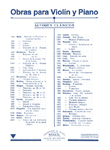WORKS
- Genre
-
Musical education
- Choir
- Counterpoint
- Dictation
- Direction
- Exam study manuals
- General music pedagogy
- Harmony
- Hearing
- Illustrations / Posters
- Improvisation / Sight reading
- Instrument methods
- Instrument pedagogy
- Instrumental study repertoire
- Instrumentation and orquestration
- Musical language
- Solfège
- Templates
- Theory and analysis
-
Incidental music
-
Lined paper
-
Flamenco
-
Religious music
-
Classical / contemporary
-
Modern music
-
Folk music / traditional
-
Musicology
-
Divulgation
-
Games and hobbies
-
Music therapy
-
Children / Youth
-
- Instruments
- Ensemble
- Difficulty level
- Period
- Genre
SOPORTE
Search
Find here: books, scores, composers, digital pieces, cd's
Best-selling works
Our classics

Newsletter
I wish to be informed of the news about your music
We have received your e-mail correctly
Multimedia
Doric-Sax
Saxofón contralto en Mib
SEBASTIÀ TORRENT, Antoni-ErnestSEBASTIÀ TORRENT, Antoni-ErnestSEBASTIÀ TORRENT, Antoni-ErnestReg.: B.3413
10,40 €
P.V.P. (VAT included 4%)
Add to cart
- Ensemble: Solo.
- Genres: Classical / contemporary: Solos.
- Product format: Partitura
- Difficulty level: Advanced-superior
- Period: 2nd half S. XX - XXI
- Publishing house: Editorial Boileau
- Collection: Siglo XXI
- No. of pages: 12
- Measure: 31,00 x 23,00 cm
- Lenght: 5'02''
- ISMN: 979-0-3503-0379-1
- Available in digital: No
- Available for rent: No
Piece for alto saxophone solo, which on the one hand studies the technical possibilities that the displayed piece offers, with a rather lyrical line with modal elements and on the other, creates a process of growth in which tension accumulates until the outburst at the piece’s culminating moment. All this should be created in a very short period of time, but always with a gradual progression. This should be the great challenge that the piece presents.
The first part is based around one mode which at the same time generates its own sub-mode, creating a sweet, expressive, delicate and emotive display, which will be followed by a rather difficult technique which seeks instability and a rather nervous continual progression.
Nevertheless, a rather in-depth study is practised in terms of this instrument’ ranges, as the first part starts in the deep range, moving to the mid range and then reaching the culminating point in the high-pitched range, also using harmonics as a reference to the piece. The second part is no longer progressive and will always be a proposal on these four different ranges, whilst other tonal resources will also be contributed, such as «slaps» and «frolatti».








